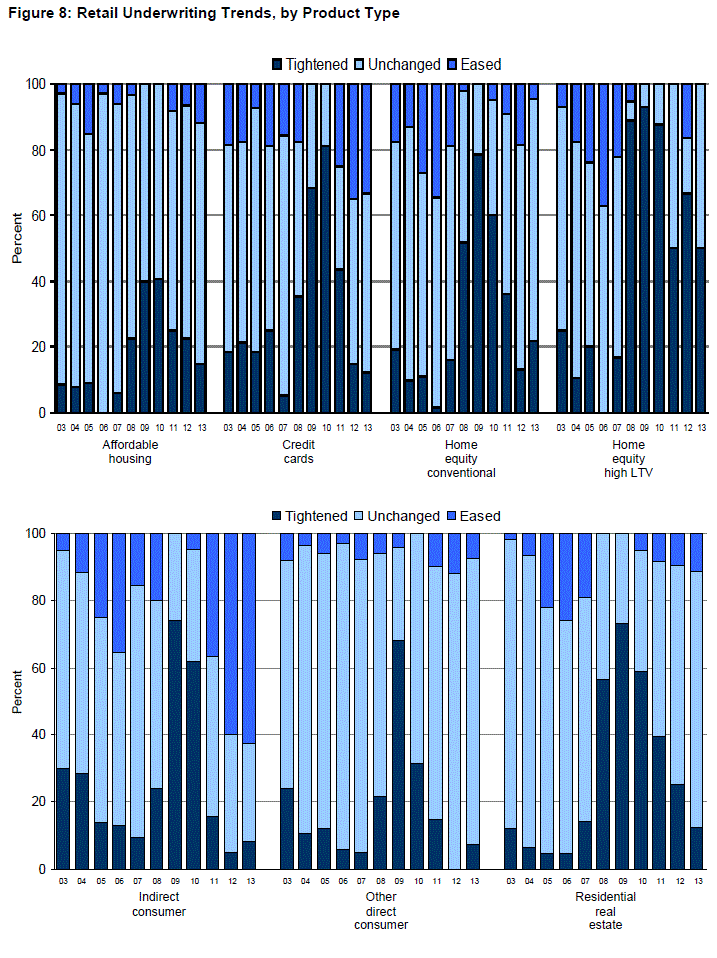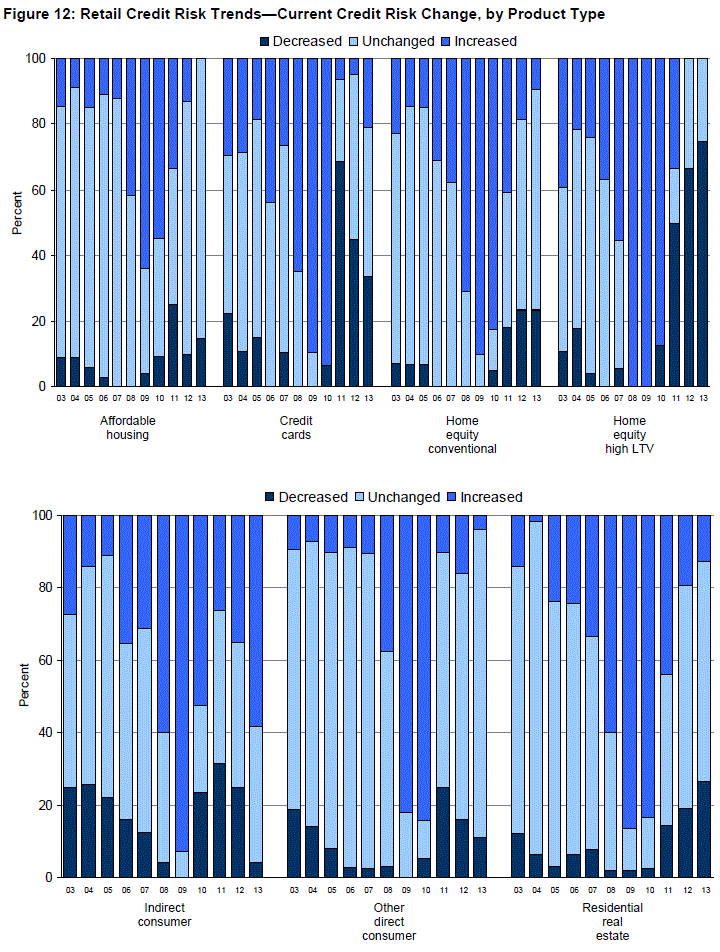Blog

Home Equity Loans Mark Exception to Easing Credit Standards
More banks are easing their underwritingrnstandards as they adapt to changing economic conditions and competition thernOffice of Comptroller of the Currency (OCC) said today as it released resultsrnof its 19th Annual Survey ofrnCredit Underwriting. Banks are relaxing underwriting for bothrncommercial and retail products, with large banks as a group reporting thernhighest share of eased standards. Some loan products, such as home equity loans, instead saw tighter standards.</p
The survey, a compilation ofrnexaminer observations and assessments, included 86 of the largest nationalrnbanks and federal savings associations and covers the 18-month period endingrnJune 30, 2013. The survey covered loans totaling $4.5 trillionrnrepresenting approximately 87 percent of total loans in the national bank andrnfederal savings association system. Elevenrncategories of commercial lending were addressed and seven categories of retailrnproducts including residential first mortgages, affordable housing, and bothrnconventional and high loan-to-value (LTV) home equity lending.</p
OCC said its examiners reported banks’rnincreasing risk appetite and greater market liquidity were factors thatrncontributed to easing standards with indirect consumer products, largerncorporate loans, credit cards, asset-based lending, international lending, andrnleveraged loans benefiting most. Despiterntheir conclusions about easing, examiners reported that mostrnbanks maintained good or satisfactory adherence to underwriting standards.</p
Seventy-eight or 91 percent of thernsurveyed banks originated residential real estate loans and 76 percent reportedrntheir residential lending standards were unchanged. Eleven percent said their standards had eased,rnup from 10 percent in 2012, while 13 percent said they had tightened requirementsrncompared to 25 percent in the previous survey and 40 percent in 2011. </p
 </p
</p
Examiners reported that the level ofrnrisk in loan portfolios had decreased or remained unchanged at 87 percent ofrnthe banks. OCC notes that although thernhousing market has experienced a noticeable recovery since the last survey twornbanks had exited the residential real estate business but none of the remainingrnbanks indicated they planned to do so in the coming year. </p
 </p
</p
Conventional home equity lending moved arnbit in the opposite direction, with loosening of standards reported at 5rnpercent of banks and tightening at 22 percent while 73 percent reported nornchange. However, in 2012 standards wererneased by 18 percent and only tightened by 14 percent. </p
It was high LTV home equity lendingrnwhich saw the most tightening. In 2012rnstandards were eased at 17 percent of institutions; in the most recent surveyrnno institutions reported relaxing lending standards. Instead they were tightened by 50 percentrn(down from 66 percent) and unchanged at 50 percent (compared to 17 percent inrnthe previous survey). </p
“This year’s survey showed arnprogression toward easing underwriting standards as the economic environmentrnstabilizes,” said John Lyons, Senior Deputy Comptroller and Chief National BankrnExaminer. He went on to indicate “that as banks ease standards to improvernmargins and compete for limited loan demand, examiners will continue to monitorrnunderwriting standards to ensure they are prudent and are applied consistentlyrnregardless of whether loans are underwritten to hold or distribute.”</p
The survey indicates that 70 percent of examiners responding expectrnthat the overall level of credit risk will either remain unchanged or increasernover the next 12 months, a decline from last year’s survey, which indicatedrnthat 77 percent of examiner responses showed an expectation for no change or anrnincrease in the level of credit risk over the next 12 months. Where examinersrnexpect risk to increase they based their responses on expectations of changesrnin the state of the economy and continued strong competition. </p
Underwriting standards, as presented in this report, refer tornthe terms and conditions under which banks extend or renew credit, such asrnfinancial reporting and collateral requirements, repayment programs, terms,rnpricing, and covenants. A conclusionrnthat underwriting standards for a particular loan category eased or tightenedrndoes not necessarily indicate an adjustment in all of the standards for thatrnparticular product but an easing or tightening of the aggregate conditionsrnunder which banks extended credit.
All Content Copyright © 2003 – 2009 Brown House Media, Inc. All Rights Reserved.nReproduction in any form without permission of MortgageNewsDaily.com is prohibited.
Latest Articles
By John Gittelsohn August 24, 2020, 4:00 AM PDT Some of the largest real estate investors are walking away from Read More...
Late-Stage Delinquencies are SurgingAug 21 2020, 11:59AM Like the report from Black Knight earlier today, the second quarter National Delinquency Survey from the Read More...
Published by the Federal Reserve Bank of San FranciscoIt was recently published by the Federal Reserve Bank of San Francisco, which is about as official as you can Read More...

Comments
Leave a Comment